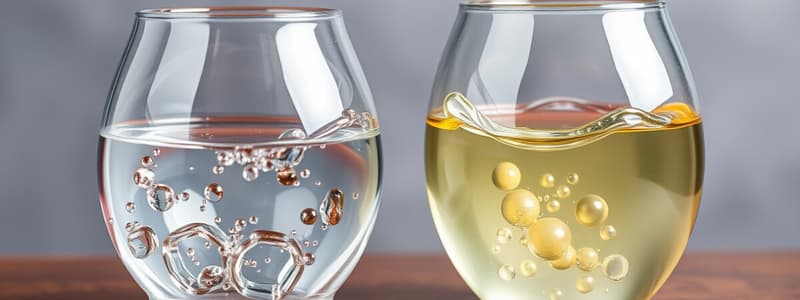Podcast
Questions and Answers
ما هي الخاصية التي تميز المواد الصلبة؟
ما هي الخاصية التي تميز المواد الصلبة؟
- حجم غير محدد
- قابلة للضغط بسهولة
- شكل وحجم محددان (correct)
- تأخذ شكل الوعاء
كيف يتحرك الجسيمات في السوائل مقارنةً بالمواد الصلبة؟
كيف يتحرك الجسيمات في السوائل مقارنةً بالمواد الصلبة؟
- تتحرك ولكن يمكن أن تمر من بعضها البعض (correct)
- تتحرك بحرية تامة
- تتحرك بطريقة مرتبة ومنظمة
- تتحرك بشكل محدود في مكانها
أي من الخصائص التالية هو صفة للغازات؟
أي من الخصائص التالية هو صفة للغازات؟
- تكون مضغوطة بشدة
- تمتلك طاقة حركية منخفضة
- تمتلك حجمًا محددًا
- تملأ شكل وحجم الوعاء (correct)
ما هي السمة الرئيسية للضغط الذي يمارسه الغاز؟
ما هي السمة الرئيسية للضغط الذي يمارسه الغاز؟
ما الذي يسبب التوتر السطحي في السوائل؟
ما الذي يسبب التوتر السطحي في السوائل؟
أي من الأنواع التالية يصف المواد الصلبة البلورية؟
أي من الأنواع التالية يصف المواد الصلبة البلورية؟
ما هو أفضل تعبير خلال المقارنة بين المواد الصلبة والسوائل؟
ما هو أفضل تعبير خلال المقارنة بين المواد الصلبة والسوائل؟
ما هي الخاصية الفيزيائية للمواد السائلة مقارنةً بالغازات؟
ما هي الخاصية الفيزيائية للمواد السائلة مقارنةً بالغازات؟
أي من الخيارات التالية يصف سلوك الجسيمات في الغازات؟
أي من الخيارات التالية يصف سلوك الجسيمات في الغازات؟
Flashcards are hidden until you start studying
Study Notes
States of Matter
Solid Properties
- Definite Shape and Volume: Solids maintain a fixed shape and volume due to closely packed particles.
- Particle Arrangement: Particles are tightly packed in a regular pattern; they vibrate in place but do not move freely.
- Incompressibility: Solids cannot be compressed significantly because particles are already closely packed.
- Low Kinetic Energy: Particles have low kinetic energy, resulting in limited movement.
- Types of Solids:
- Crystalline: Have a well-ordered structure (e.g., salt, diamond).
- Amorphous: Lack a definite structure (e.g., glass, rubber).
Liquid Behavior
- Definite Volume, Indefinite Shape: Liquids have a fixed volume but take the shape of their container.
- Particle Arrangement: Particles are close together but can move past one another, allowing for fluidity.
- Moderate Kinetic Energy: Particles have more kinetic energy than in solids, enabling them to flow.
- Incompressibility: Liquids are largely incompressible but can be slightly compressed under extreme pressure.
- Surface Tension: The cohesive forces between liquid molecules result in surface tension, causing liquids to minimize surface area.
- Viscosity: A measure of a liquid's resistance to flow; varies with temperature and intermolecular forces.
Gas Characteristics
- Indefinite Shape and Volume: Gases expand to fill the shape and volume of their container.
- Particle Arrangement: Particles are far apart and move freely, resulting in a low density.
- High Kinetic Energy: Particles have high kinetic energy, allowing for rapid movement and collisions.
- Compressibility: Gases are highly compressible due to the significant space between particles.
- Diffusion: Gases mix and spread rapidly due to high kinetic energy and low intermolecular forces.
- Pressure: Gases exert pressure on their container walls, influenced by the number of collisions of particles.
خصائص المادة
خصائص المواد الصلبة
- شكل وحجم ثابت: تتمتع المواد الصلبة بشكل وحجم ثابت بسبب تجمع الجزيئات بالقرب من بعضها.
- ترتيب الجزيئات: الجزيئات مرتبة في نمط منتظم، تهتز في مكانها لكن لا تتحرك بحرية.
- غير قابلة للضغط: لا يمكن ضغط المواد الصلبة بشكل كبير لأن الجزيئات متراصة بالفعل.
- طاقة حركية منخفضة: تمتلك الجزيئات طاقة حركية منخفضة، مما يسمح بحركة محدودة.
- أنواع المواد الصلبة:
- بلورية: تتمتع بهيكل منظم جيد (مثل: الملح، الماس).
- غير بلورية: تفتقر إلى هيكل محدد (مثل: الزجاج، المطاط).
سلوك السوائل
- حجم ثابت وشكل غير ثابت: السوائل تحتفظ بحجم ثابت لكنها تأخذ شكل الحاوية التي تحتويها.
- ترتيب الجزيئات: الجزيئات قريبة من بعضها ولكن يمكنها التحرك فيما بينها، مما يسمح بتدفقها.
- طاقة حركية متوسطة: تمتلك الجزيئات طاقة حركية أكثر مما في المواد الصلبة، مما يمكّنها من التدفق.
- غير قابلة للضغط: السوائل غالباً ما تكون غير قابلة للضغط لكنها يمكن أن تضغط قليلاً تحت ضغط شديد.
- توتّر السطح: القوى التلاصقية بين جزيئات السائل تؤدي إلى توتر السطح، مما يسبب تقليل المساحة السطحية للسوائل.
- اللزوجة: تقيس مقاومة السائل للتدفق، وتتفاوت وفقاً لدرجة الحرارة والقوى بين الجزيئات.
خصائص الغازات
- شكل وحجم غير ثابت: تنتشر الغازات لملء شكل وحجم حاويتها.
- ترتيب الجزيئات: الجزيئات متباعدة وتتحرك بحرية، مما يؤدي إلى كثافة منخفضة.
- طاقة حركية عالية: تمتلك الجزيئات طاقة حركية عالية، مما يسمح بالحركة السريعة والاصطدامات.
- قابلية الضغط: الغازات قابلة للضغط بشكل كبير بسبب المساحة الكبيرة بين الجزيئات.
- الانتشار: تمتزج الغازات وتنتشر بسرعة بسبب الطاقة الحركية العالية وضعف القوى بين الجزيئات.
- الضغط: تمارس الغازات ضغطاً على جدران الحاوية، ويتأثر هذا الضغط بعدد الاصطدامات بين الجزيئات.
Studying That Suits You
Use AI to generate personalized quizzes and flashcards to suit your learning preferences.




